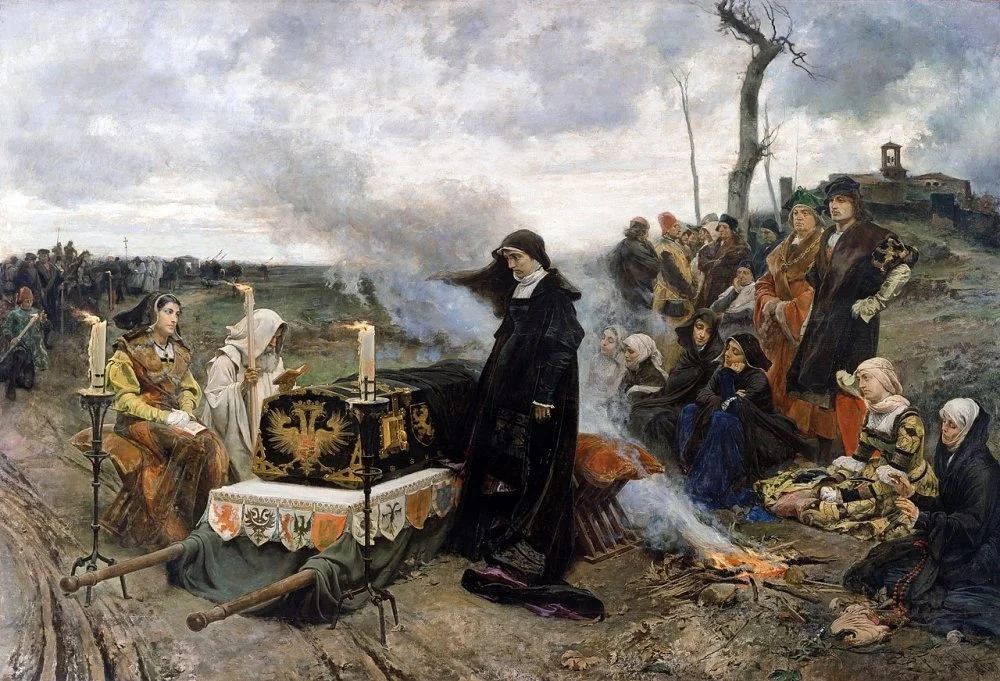Doña Joanna the Mad
A painting of how to spend a honeymoon with a dead person

Francisco Pradilla Ortiz. "Doña Joanna the Mad". 1877 / Wikipedia Commons
Prado, Madrid
This large canvas (3.4 by 5 meters) was a huge success at the 1878 Paris Exhibition (Exhibition Universelle). The Spanish artist managed to strike a chord with the European public, which at the time was terribly in love with detective stories, horror stories, spiritualism, and Gothic mysticism.
The story depicted in the painting combines all of the above.
Joanna the Mad, one of the four daughters of Isabella and Ferdinand, “the Catholic Monarchs of Spain,” was the heiress of Castile: in 1496 she married the Duke of Burgundy, Philip, who was nicknamed “the Fair.” The bride was 17, the groom 19. According to contemporaries, he was indeed very handsome. These same accounts usually pass over the bride's appearance with polite silence. Over the next eight years, Juana gave birth to five children and experienced all the agonies of wounded ego and offended love, in addition to the usual hardships of pregnancy and childbirth. Her husband was never inclined to be faithful to her, and he never missed an attractive maid of honor, not a single noble lady who had the nerve to show the prince her affections.
We can only guess whether it was the exhausting work or burning jealousy that caused Joanna to lose her mind. But after eight years, the young woman was in such a state that even her own father and mother, meeting with her, were forced to admit that the potential queen of Castile was, to put it mildly, incapacitated. No one would consider such trifles as endless scandals with her husband or shaving his favorite's hair; but Joanna's speech was incoherent, her behavior erratic. Seeing this, her parents drew up a document in which Joanna would still inherit Castile after her mother's death, but only nominally, with her father, Ferdinand, as the real ruler. Isabella did indeed die soon, and Joanna's father and husband began to fight over who had more rights to rule Castile. Philip the Fair died suddenly in 1506 — officially of smallpox, although there were rumors of poisoners sent to the handsome duke by his father-in-law.
Joanna was pregnant with her sixth child, the Infanta Catilina, and she went mad with grief. She forbade her husband to be buried and drove his coffin around the country, from monastery to monastery, periodically opening the lid and admiring the deceased, while not allowing any woman, not even a nun, to come near him: she was still madly jealous.
Finally, the father managed to put an end to this mad display. He sent his son-in-law to the crypt, and Joanna was escorted with all the honors to be imprisoned in a remote castle, where she was free to freak out as much as possible. Joanna the Mad ate only cheese and bread, and she forbade people to see her eat. She categorically refused to wash or comb her hair and spoke only to her daughter. It was decided that the Infanta Catilina should stay with her mother, and the girl, who was only taken from Joanna when she was a teenager, absorbed many of her mother's quirks; it took a long time for the little savage to become accustomed to normal life.
Joanna was later taken care of by her eldest son. The mad queen lived in her world of dark dreams until she was 75 years old.
The painting shows us an episode from this "honeymoon in the afterlife": the pregnant Joanna, dressed as a widow, prepares to open her lover's coffin once again to kiss his cold lips and share her feelings with him. The artist's historical error is the presence of female figures in her entourage (according to all sources, Joanna did not allow even her most trusted maids to be near her at that moment). The candles trembling in the wind, the smoke from the fire lit not so much for warmth as to suppress the stench of decomposition, the dull clouds of the gloomy sky - all this gives the painting, which is very realistic in other details, a ghostly, illusory effect, helping the viewer to remain in two worlds at once. In the familiar earthly world, cold and tired guards, servants and monks are forced to obey the mad ravings of a sick woman and try to make themselves comfortable in the camp, wrapping themselves in cloaks and exchanging sympathetic and skeptical glances. At the same time, there is the smoky world of restless spirits, where Joanna wanders; she makes no distinction between the dead and the living, and carries her jealousy, if not love, across the final threshold.

Francisco Pradilla Ortiz."Doña Joanna the Mad". 1877 / Wikipedia Commons



